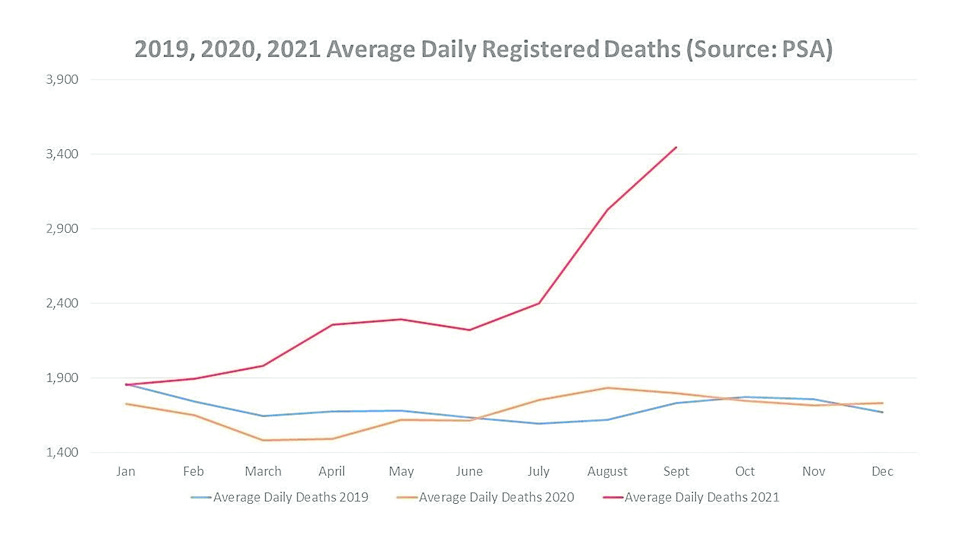(Conclusion)
A research panel from the Concerned Doctors and Citizens of the Philippines (CDC PH) reported an alarming excess of deaths in the Philippines for the year 2021, which may exceed 450,000 when the final figures on deaths from all causes are released by the Philippine Statistics Authority (PSA).
Excess deaths include those due to COVID-19 as reported by the Department of Health (DOH), undiagnosed cases of COVID-19, and deaths due to other causes which could have likely not happened if we didn’t have the pandemic. This may be due to failure of continuing optimal care of patients with chronic illnesses or delay in the diagnosis of cancer and other cases, requiring prompt evaluation and treatment.
The excess deaths can also reflect the impact of lockdowns and restriction on the mobility of the citizens, and the fear and negative mindset in a big percentage of the population, making them intently focused on evading the virus but inadvertently neglecting other more life-threatening medical problems.
Monitoring the excess deaths during a protracted crisis is a crucial part of determining if the national strategy to address the pandemic is effective in attaining the principal objective of all interventions—that is, to save lives. We recall President Duterte saying during the early part of the pandemic that saving lives was our main goal, and every life saved is well worth all the effort, including draconian interventions that the government needed to implement.
Barest minimum
Because of this all-important goal of saving lives, we would have expected our health officials to be actively monitoring the excess deaths preferably on a weekly, monthly or, at the very least, quarterly basis. This will reflect the bottom line of all interventions—that is, if we’re successful in reducing the excess deaths to the barest minimum. It is not really effective management of the pandemic if we’re able to reduce the number of people dying from COVID-19 but have an excess of deaths due to other causes.
It is understandable that the final figures on deaths coming from the PSA may take a few months to complete. But we should have some preliminary figures within 30 days, and if the preliminary figures already give us an alarming level of excess deaths, that should already guide our policymakers to make the necessary revisions or adjustments in its strategies.
The public would appreciate it if the DOH could report on the excess deaths even just on a monthly basis instead of the daily reporting of numbers of newly confirmed cases, recoveries and deaths. What are perhaps more meaningful and should be retained are the positivity rate, the reproduction number (Ro) or the infectiousness of the virus, and the occupancy status of hospitals, particularly the intensive care units. It cannot be overemphasized that a close monitoring and analysis of the excess deaths is the final bottom line that tells us if we’re winning the COVID-19 battle or not.

Shown here are the average daily deaths in 2019 (blue line), 2020 (yellow line) and 2021 up to September (red line). No excess death is noted in 2020, the first year of the pandemic, compared to the previous year with no pandemic. An unprecedented increase in deaths is noted starting in March 2021, peaking in September.
Source of data: Philippine Statistics Authority/Concerned Doctors and Citizens of the Philippines
What is quite interesting, but alarming about the CDC PH data on excess deaths was that the spikes in excess deaths appear to coincide with the rollout of mass vaccination starting March of last year. The number of excess deaths tended to correlate well with the number of vaccination shots given. As more vaccinations were given particularly in the third quarter, so was the number of excess deaths.
Could the COVID-19 deaths not account for the number of excess deaths? Partly yes, but there were six to seven times more the number of diagnosed COVID deaths as reported by the DOH during the period from March to September 2021. And in March to December 2020, as well as January and February of 2021 when we already experienced recurrent surges in COVID-19, there was no such magnitude of deaths reported.
How about deaths due to other known common causes, like heart attack and stroke and cancers? Well, these may very well account for a good number of the excess deaths, but in 2020 when we had stricter lockdowns, and it could be assumed that patients didn’t get to follow up with their doctors regularly, too, there were no excess deaths from these causes.
It’s really a puzzle. If you search for possible death-causing factors from March to September 2021, you’ll really be at a loss. Birth and death data in populations are usually quite steady, barring wars or natural disasters of catastrophic proportions.
15 jets crashing every week
What could have caused so many Filipinos to die, roughly equivalent to 465 fully loaded Boeing 747 jumbo jets crashing? That’s like 15 of these giant jets crashing every week, or more than two every day for that period.
That should have caught some attention, but there seems to be no explanation, or even just an announcement that our health officials are well aware of it but found it to be of no importance.
If you ask the head of the CDC PH research panel, who requests to remain anonymous for security reasons, the mass vaccination rollout starting March 2021 sticks out like a sore thumb as a possible factor to consider in the sudden spike of deaths last year.
She closely monitored the development of the vaccines and their initial testing. With the initial testing, it became clear to her that information was being suppressed.
She says: “So many social media groups and individuals reporting anything negative were removed. Then I started to hear stories (of deaths and adverse events) from and within the groups that I am in—groups in the United States, Australia, the Philippines; and soon after, even from personal friends. These were all brushed off as anecdotal and coincidental, and the ‘safe and effective dogma’ continued. Clearly, we needed concrete, indisputable data to show what was happening!”
She and her research team persevered for months in monitoring the PSA website for new data drops until the monthly data were fairly complete.
As the data got completed, the alarm bells started ringing in their heads. Weren’t our population scientists closely watching these data, she asked?
“When I realized [the implications of the data] I was seeing, I was literally crying and shaking! That triggered me to further evaluate the data, first on a countrywide and then on a regional basis [selected areas],” she says. “Universally, there are big increases in death rates in 2021, only starting in March, concurrent with the vaccine rollout. There were no wars, natural disasters, or even widespread illness.”
She explains that these big increases in death rates cannot be attributed to COVID-19, which has a very low infection fatality (death) rate.
“We must assume that the vaccines are guilty unless conclusively proven otherwise,” she says.
Excess deaths (in percentages) were noted in practically all key cities: +12 in Manila; +32 in Mandaluyong; +23 in Marikina; +35 in Pasig; +34 in Quezon City; +26 in San Juan; +42 in Cebu City; +30 in Negros Oriental; +39 in Iloilo; and +43 in Davao City.
Vaccine obsession
The CDC PH report also includes a decreasing birth rate which was already noted from the start of the pandemic, unlike the increasing death rate which occurred only starting March 2021.
“This shows us that lockdowns are devastating for families and affect their willingness and ability to have children. However, it did not, at least in 2020, result in excess deaths. The increase in deaths coincided directly with the vaccine rollouts,” the CDC PH expert explains.
It may be easy to attribute the decreasing birth rate to the overall effect of the pandemic, but the isolated crossing of the lines in September 2021—with the number of deaths exceeding the number of births—does not seem to herald yet a depopulation mode in our country. But if that trend persists, then we may have to start considering it and start making long-term projections.
Could the mass vaccination in pregnant women be partly responsible for the decreasing birth rates? We believe there’s no strong evidence at the moment to implicate it, but it’s too early to say.
There are reports abroad, though, showing increasing number of miscarriages in the second trimester and stillbirths in the last trimester, possibly vaccine-induced. The problem is, the various governments and regulatory agencies seem to be too polite to ask vaccine manufacturers to be transparent with all the data they have at hand on serious side effects reported in the clinical trials and postmarketing. In some countries, it requires court injunctions to compel the pharma companies to present safety data. We may have to do it here also.
We just can’t be kept in the dark or pass this off as acceptable when the chief executive officer of a vaccine manufacturer says in a cavalier manner that their vaccines are not as effective as they thought they would be. They promised vaccines that would prevent infection and could make us attain herd immunity once a certain percentage of the population is vaccinated. Now, it appears the more a population is vaccinated, the more the number of breakthrough infections when a new variant comes.
Ask the vaccine czars of Israel, the United Kingdom and Japan. That’s the reason they’re now dumping their vaccine passes and stopping the discrimination against the unvaccinated. Many other countries are following suit. But here, we’re sticking to our vaccinate-all strategy and pressure the unvaccinated by subjecting them to all sorts of restrictions and discrimination.
The marching order is to give the jabs, shorten the boosting period with vaccines, which the manufacturer CEO himself admits to being not as effective as they were expected to be with the dominant variant now. It’s about time we reboot our mindsets and cure ourselves of our vaccine obsession. INQ












































